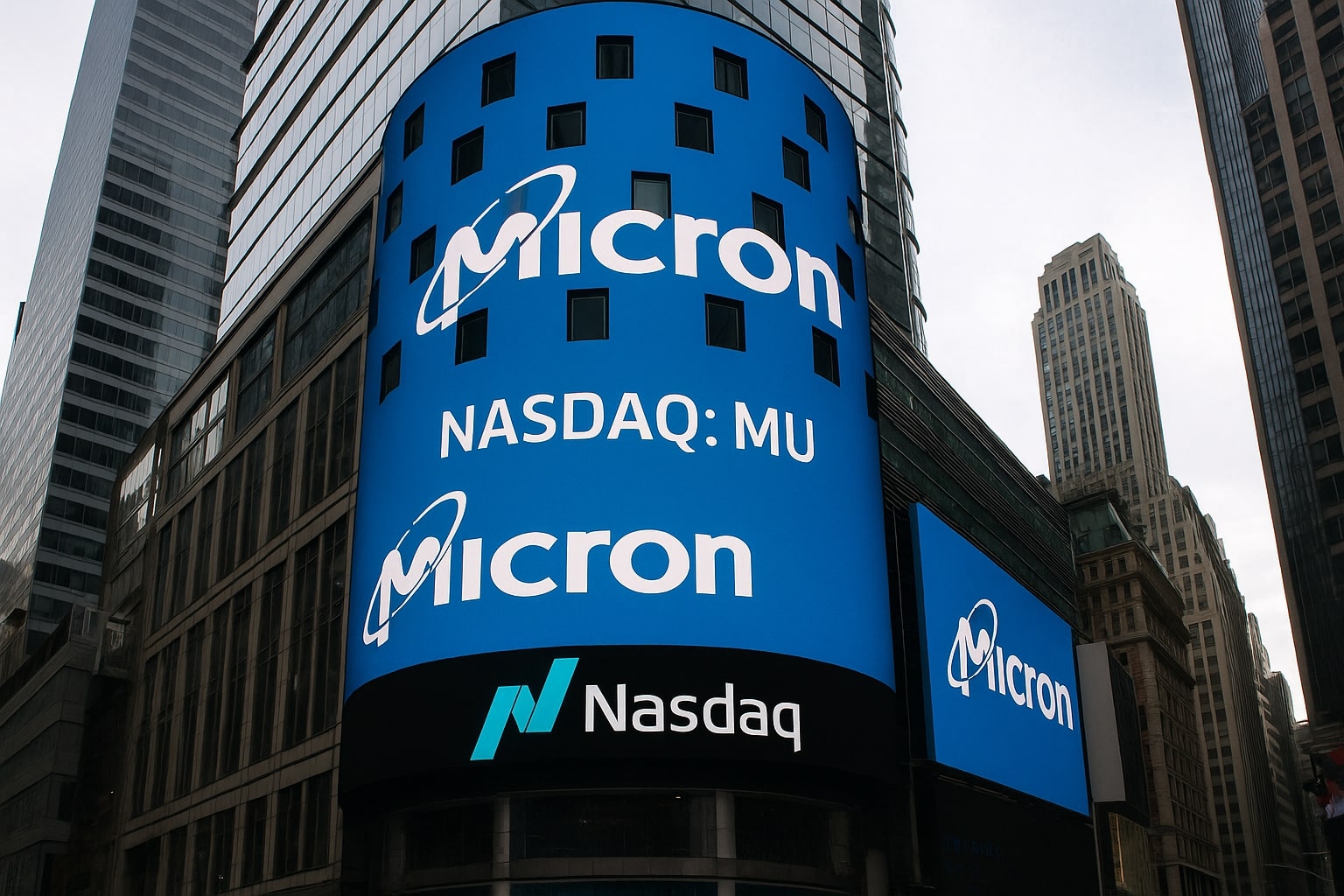
Micron Stock Price Forecast: NASDAQ:MU at $117 Eyes $173 as HBM and AI Demand Surge
Strong AI-driven memory demand, record revenue, and U.S. expansion keep Micron positioned for margin recovery above 40% with HBM4 ramp adding long-term upside | That's TradingNEWS
Micron Technology (NASDAQ:MU) Stock Analysis: AI-Driven Demand, HBM Ramp, and Margin Pressure
Micron Technology NASDAQ:MU has undergone a dramatic transformation over the past two years, shifting from cyclical weakness to becoming one of the most strategically positioned semiconductor suppliers in the AI era. The company’s fiscal Q3 2025 results marked a turning point, with revenue reaching record levels, gross margins recovering toward the 40% mark, and high-bandwidth memory (HBM) establishing itself as the key growth driver. Yet, despite this surge, the stock still trades at a discount to peers, giving investors a rare valuation opportunity. The central question remains whether margin pressure from consumer segments and looming supply constraints can derail Micron’s AI-fueled trajectory.
HBM Revenue Growth Accelerates With AI Demand
Micron’s core story today revolves around HBM. Demand for HBM3E has been explosive, with sequential revenue growth of nearly 50% in the most recent quarter, and management confirmed that the company’s HBM supply is completely sold out for calendar year 2025. This comes as AMD’s Instinct MI355X GPU platform, a flagship AI accelerator shipping with Micron’s 36GB HBM3E 12-high stacks, entered ramped production in June. Beyond AMD, Micron is shipping HBM in mass volumes to four key customers, including ASIC platforms, a sign of its broadening adoption across AI workloads.
Looking forward, the pipeline is even stronger. HBM4 has already entered sampling with major customers, with ramp expected in the first half of 2026. Street models anticipate a steep increase in EPS in fiscal Q2 and Q3 2026 aligned with this transition. From a market share standpoint, Micron expects HBM penetration to reach parity with its overall DRAM share in the second half of 2025—a significant milestone in establishing itself as a leader against Samsung and SK Hynix in the high-bandwidth memory race.
Revenue Strength and Guidance Revisions
Micron’s FQ3 2025 revenue surged 15% sequentially and 37% year-over-year, exceeding expectations by nearly $475 million. The company guided FQ4 revenue to $10.7 billion (±$300 million), reflecting sustained demand from hyperscaler capex and AI deployments. Analysts have revised full-year estimates higher, with consensus now expecting revenue growth close to 39% on average in the upcoming annual report. This performance underscores the structural demand lift from data centers and AI workflows, where memory bandwidth is a bottleneck and Micron’s solutions are increasingly mission-critical.
The data center and AI segment has more than doubled year-over-year, setting a quarterly revenue record. With hyperscalers and cloud providers targeting roughly $80 billion in capex for data center and AI infrastructure in 2025 alone, Micron sits at the heart of this spending wave. AI-enabled workloads across cloud, enterprise, and edge devices continue to drive unprecedented demand for both DRAM and NAND.
Gross Margin Recovery and Risks Ahead
Despite revenue strength, margins remain a focal point. Non-GAAP gross margins improved by 110 basis points sequentially to 39% in FQ3, but management sees further gains to 44.5% in FQ4 as pricing leverage builds and supply tightens. Still, consumer-driven product mix weighed on profitability. DRAM average selling prices declined by low single digits sequentially, while NAND prices dropped by high single digits due to softness in mobile and PC markets. This diluted Micron’s high-value mix, offsetting some of the benefits from HBM’s ramp.
Supply constraints represent another challenge. Leading-edge DRAM nodes like 1-beta and 1-gamma remain tight, limiting near-term shipments of Micron’s most profitable products. CFO Mark Murphy highlighted that inventories are particularly thin on these advanced nodes, though the company expects to shift its mix toward higher-value DRAM and NAND, which should support margin expansion heading into fiscal 2026. The balance sheet shows $10.8 billion in cash and equivalents against $16 billion in debt, but with an interest coverage ratio of 17.6x, Micron’s financial position remains robust.
Capital Expenditures and U.S. Expansion
Micron is aggressively investing over $20 billion in capex over the next two years to scale advanced node DRAM and NAND capacity, particularly through U.S.-based fabs supported by CHIPS Act incentives. This expansion is designed to enhance supply chain resilience, reduce reliance on overseas production, and mitigate tariff and geopolitical risks. With U.S.-China trade tensions ongoing, Micron’s proactive reshoring strategy adds strategic value by insulating operations from potential disruptions.
Valuation Remains Attractive Relative to Peers
Despite its strong turnaround, Micron’s valuation remains compelling. The stock trades at just 16.5x next year’s earnings, significantly below the semiconductor industry median of 29.8x. On a price-to-operating-cash-flow basis, the multiple has fallen from the mid-40s in 2024 to well below its five-year average, earning Micron an “A” grade in this metric relative to peers. Conservative DCF models point to an intrinsic value of around $173 per share, implying 47% upside from current levels near $117. This aligns closely with Street consensus, reinforcing the argument that Micron is undervalued despite its pivotal role in AI infrastructure.
Verdict: Strong Buy With $173 Price Target
Micron NASDAQ:MU has evolved into a fundamentally stronger company than it was two years ago. AI adoption has structurally shifted memory demand, and Micron’s leadership in HBM positions it at the forefront of this secular growth cycle. While near-term risks from consumer pricing and bit supply constraints remain, the tailwinds from data center expansion, HBM4 ramp in 2026, and strategic U.S. manufacturing expansion are overwhelming. Trading at just 16.5x forward earnings and significantly below sector medians, Micron is mispriced relative to its growth prospects. I rate the stock a Strong Buy, with a 12-month price target of $173, representing nearly 50% upside potential.
Read More
-
PPA ETF at $154: Can This Defense ETF Keep Beating ITA and SPY?
14.12.2025 · TradingNEWS ArchiveStocks
-
XRP ETFs XRPI and XRPR Pull In $975M While XRP-USD Fights To Hold $2
14.12.2025 · TradingNEWS ArchiveCrypto
-
Natural Gas Price Forecast: NG=F Hits $4.11 As Warm Winter Outlook Puts $3.913 Support At Risk
14.12.2025 · TradingNEWS ArchiveCommodities
-
USD/JPY Price Forecast - Dollar to Yen Can BoJ’s 0.75% Shock Break The 155–158 Range?
14.12.2025 · TradingNEWS ArchiveForex


















